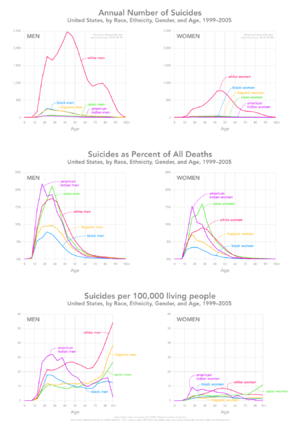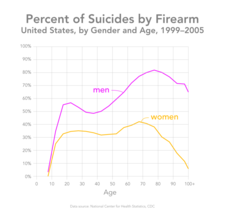Suicide
2008/9 Schools Wikipedia Selection. Related subjects: Health and medicine
| Suicide |
|---|
| History |
|
List of suicides · Suicide rate |
| Views |
|
Medical · Cultural · Legal · Philosophical · Religious · Right to die |
| Suicide crisis |
|
Assessment of suicide risk · Intervention · Prevention · Crisis hotline · Suicide watch |
| Suicide methods |
|
Copycat suicide · Cult suicide · Euthanasia · Familicide · Forced suicide · Internet suicide · Mass suicide · Murder-suicide · Ritual suicide · Suicide attack · Suicide pact · Suicide by cop · Teenage suicide |
| Related phenomena |
|
Self-harm · Suicidal ideation · Suicide note |
Suicide (Latin suicidium, from sui caedere, to kill oneself) is the act of terminating one's own life. Many dictionaries also note the metaphorical sense of "willful destruction of one's self-interest". Suicide may occur for a number of reasons, including depression, shame, pain, financial difficulties, or other undesirable situations. Nearly one million people worldwide die by suicide annually, making it one of the world's leading causes of death. There are an estimated 10 to 20 million attempted suicides every year.
Views on suicide have been influenced by cultural views on existential themes such as religion, honour, and the meaning of life. Most Western and some Asian religions—the Abrahamic religions, Hinduism—consider suicide a dishonorable act; in the West it was regarded as a serious crime and an offense towards God due to religious belief in the sanctity of life. Japanese views on honour and religion led to seppuku, one of the most painful methods of suicide, to be respected as a means to atone for mistakes or failure, or as a form of protest during the samurai era. In the 20th century, suicide in the form of self-immolation has been used as a form of protest, and in the form of kamikaze and suicide bombing as a military or terrorist tactic. Sati was a Hindu funeral practice in which the widow would immolate herself on her husband's funeral pyre.
Medically assisted suicide ( euthanasia, or the right to die) is a controversial ethical issue involving people who are terminally ill, in extreme pain, and/or have minimal quality of life through injury or illness. Self-sacrifice for others is not usually considered suicide, as the goal is not to kill oneself but to save another.
The predominant view of modern medicine is that suicide is a mental health concern, associated with psychological factors such as the difficulty of coping with depression, inescapable suffering or fear, or other mental disorders and pressures. Suicide is sometimes interpreted in this framework as a "cry for help" and attention, or to express despair and the wish to escape, rather than a genuine intent to die. Most people who attempt suicide do not complete suicide on a first attempt; those who later gain a history of repetitions are significantly more at risk of eventual completion.
Suicidal phenomena
Suicidal ideation
Suicidal ideation is a medical term for thoughts about suicide, which may range from vague or unformed urges to meticulously detailed plans and posthumous instructions. The condition requires professional intervention to determine its extent, including the presence of a suicide plan and the patient's means to commit suicide. Severe suicidal ideation is a medical emergency requiring immediate treatment.
Suicidal gestures and attempts
Sometimes, a person will make actions resembling suicide attempts while not being fully committed. This is called a suicidal gesture. Prototypical methods might be a non-lethal method of self-harm that leaves obvious signs of the attempt, or simply a lethal action at a time when the person considers it likely that he/she will be rescued or prevented from fully carrying it out.
On the other hand, a person who genuinely wishes to die may survive, due to lack of knowledge, unwillingness to try methods that may end in permanent damage to her- or himself (in the event of an attempt which does not result in death), unwillingness to try methods which may harm others, an unanticipated rescue, among other reasons. There may be conflict, whereby a genuinely suicidal person can be desperate enough to want to kill themselves but at the same time, too afraid to go through with the extreme measures that are needed to guarantee death. It may be incorrect to state that a person who survived an overdose was issuing a 'cry for help' when in reality it was a suicide attempt that simply did not result in death. This highlights a basic fact that it is not easy to kill oneself in a way that is not traumatic or painful, hence the phenomenon of assisted suicides. This is referred to as a suicide attempt.

Distinguishing between a suicide attempt and a suicidal gesture may be difficult. Intent and motivation are not always fully discernible since so many people in a suicidal state are genuinely conflicted over whether they wish to end their lives. One approach, assuming that a sufficiently strong suicide intent will ensure death, considers all near-suicides to be suicidal gestures. This, however, does not explain why so many people whose suicide attempts do not result in death end up with severe injuries, often permanent, which are most likely undesirable to those who are making a suicidal gesture. (See: self-harming.) Another possibility is those wishing merely to make a suicidal gesture may end up accidentally killing themselves, perhaps by underestimating the lethality of the method chosen or by overestimating the possibility of external intervention by others. Suicide-like acts should generally be treated as seriously as possible, because if there is an insufficiently strong reaction from loved ones from a suicidal gesture, this may motivate future and ultimately more committed attempts.
In the technical literature the use of the terms parasuicide, or deliberate self-harm (DSH) are preferred – both of these terms avoid the question of the intent of the actions.
Nearly half of all suicides are preceded by an attempt at suicide that does not end in death. Those with a history of such attempts are 23 times more likely to eventually end their own lives than those without. Those who attempt to harm themselves are, as a group, quite different from those who actually die from suicide; females attempt suicide much more frequently than males, however males are four times more likely to die from suicide.
Suicide crisis
A suicide being attempted, or a situation in which a person is seriously contemplating suicide or has strong suicidal thoughts, is considered by public safety authorities to be a medical emergency requiring suicide intervention.
Suicide note
A suicide note is a written message left by someone who attempts, or dies by suicide, though a large number of people who complete suicide do not leave one. Studies give inconsistent results as to the proportion of people who leave suicide notes - with a range of approx. 12 to 37%. Motivations for leaving a note range widely, from seeking closure with loved ones to exacting revenge against others by blaming them for the decision. It may also contain a few sentences apologizing to those they have left behind.
Epidemiology
According to official statistics, about a million people die by suicide annually, more than those murdered or killed in war. According to 2005 data, suicides in the U.S. outnumber homicides by nearly 2 to 1 and ranks as the 11th leading cause of death in the country, ahead of liver disease and Parkinson's disease.
Gender and suicide: In the Western world, males die much more often by means of suicide than do females, although females attempt suicide more often. This pattern has held for at least a century. Some medical professionals believe this stems from the fact that males are more likely to end their lives through effective violent means ( guns, knives, hanging, etc.), while women primarily use more failure-prone methods such as overdosing on medications; again, this has been the case for at least a century.
Others ascribe the difference to inherent differences in male/female psychology. Greater social stigma against male depression and a lack of social networks of support and help with depression are often identified as key reasons for men's disproportionately higher level of suicides, since suicide as a "cry for help" is not seen by men as an equally viable option. Typically males die from suicide three to four times more often as females, and not unusually five or more times as often.
Excess male mortality from suicide is also evident from data from non-western countries. In 1979–81, 74 territories reported one or more cases of suicides. Two of these reported equal rates for both sexes: Seychelles and Kenya. Three territories reported female rates exceeding male rates: Papua New Guinea, Macau, French Guiana. The remaining 69 territories had male suicide rates greater than female suicide rates.
Barraclough found that the female rates of those aged 5–14 equaled or exceeded the male rates only in 14 countries, mainly in South America and Asia.
National suicide rates sometimes tend to remain stable. For example, the 1975 rates for Australia, Denmark, England, France, Norway, and Switzerland were within 3.0 per 100,000 of population from the 1875 rates. The rates in 1910–14 and in 1960 differed less than 2.5 per 100,000 of the population in Australia, Belgium, Denmark, England and Wales, Ireland, Japan, New Zealand, Norway, Scotland, South Africa, Spain, Sweden, and the Netherlands.
| Rank | Country | Males | Females | Total | Year |
|---|---|---|---|---|---|
| 1 | 70.1 | 14.0 | 40.2 | 2004 | |
| 2 | 63.3 | 10.3 | 35.1 | 2003 | |
| 3 | 61.6 | 10.7 | 34.3 | 2004 | |
| 4 | 51.0 | 8.9 | 29.2 | 2003 | |
| 5 | 44.9 | 12.0 | 27.7 | 2003 | |
| 6 | 42.5 | 12.1 | 27.2 | 2003 | |
| 7 | N/A | N/A | 26.1 | 2005 | |
| 8 | 37.9 | 13.9 | 25.6 | 2004 | |
| 9 | 42.9 | 8.5 | 24.3 | 2004 | |
| 10 | 35.6 | 12.8 | 24.0 | 2004 |
There are considerable differences in national suicide rates among various countries. Findings from two studies showed a range from 0 to more than 40 suicides per 100,000 of population.
National suicide rates, apparently universally, show a long-term upward trend. This trend has been well-documented in European countries. The trend for national suicide rates to rise slowly over time might be an indirect result of the gradual reduction in deaths from other causes, i.e. falling death rates from causes other than suicide uncover a previously hidden predisposition towards suicide. There may also be an explanation in the reduced stigma attached to survivors as suicide is no longer considered a crime or a sin. This may allow coroners to record more suicides as such and so increase stats.
Ethnic groups and suicide: In the USA, Asian-Americans are more likely to die by suicide than any other ethnic group. Caucasians die by suicide more often than African Americans do. This is true for both genders. Non-Hispanic Caucasians are nearly 2.5 times more likely to kill themselves than are African Americans or Hispanics.
Age and suicide: In the USA, males over the age of seventy die by suicide more often than younger males. There is no such trend for females. Older non-Hispanic Caucasian men are much more likely to kill themselves than older men or women of any other group, which contributes to the relatively high suicide rate among Caucasians.
Season and suicide: People die by suicide more often during spring and summer. The idea that suicide is more common during the winter holidays (including Christmas in the northern hemisphere) is a common misconception. There is also potential risk of suicide in some people experiencing Seasonal affective disorder. Some studies have found that elderly people are more likely to commit suicide around their birthdays.
Related phenomena
Euthanasia and assisted suicide
Individuals who wish to end their own life may enlist the assistance of another person to achieve death, e.g. by a deadly poison. The other person, usually a family member or physician, may help carry out the act if the individual lacks the physical capacity to do so even with the supplied means. According to different moral views, this may not be considered a form of suicide. The assistant may think of it as acting in behalf of the individual, perhaps to end suffering, while opponents regard it as akin to murder. Assisted suicide is a contentious moral and political issue in many countries, as seen in the scandal surrounding Dr. Jack Kevorkian, a medical practitioner who supported euthanasia, was found to have helped patients end their own lives, and was sentenced to jail time.
Murder-suicide
A murder-suicide is an act in which an individual kills one or more other persons immediately before, at the same time as, or after killing him or herself.
The combination of murder and suicide can take various forms, including:
- Suicide to facilitate murder, as in suicide bombing
- Suicide after murder to escape punishment
- Suicide after murder as a form of self-punishment due to guilt
- Having a combined objective of suicide and murder
- Considering one's suicide as the main act, but murdering one's children first, to avoid them becoming orphans, to be together in an expected afterlife, in the context of severe depression where the person feels he is sparing his loved ones from a horrible life, or simply just to experience the act
- Joint suicide in the form of killing the other with consent, and then killing oneself
- Punishment - taking revenge on those deemed responsible and escaping the world seen as a terrible place, as in many school shootings
- Some cases of cult suicide may also involve murder. Conversely, many spree killings have ended in suicide.
The motivation for the murder in murder-suicide can be purely criminal in nature or be perceived by the perpetrator as an act of care for loved ones in the context of severe depression. The severely depressed person may see the world as a terrible place and can feel that they are helping those they care about by removing them from it. Thoughts like this are generally regarded as a medical emergency requiring suicide intervention.
Since crime just prior to suicide is often perceived as being without consequences, it is not uncommon for suicide to be linked with homicide. Motivations may range from guilt to evading punishment, insanity, part of a suicide pact, or exacting revenge on those whom they feel are responsible.
A famous example of murder-suicide is the double murder-suicide of professional wrestler Chris Benoit, who was found hanging in his home along with the bodies of his wife and son.
Suicide attack
A suicide attack is when an attacker perpetrates an act of violence against others, typically to achieve a military or political goal, that foreseeably results in his or her own death as well. Suicide bombings have been prominent in the news in recent years as an act of terrorism. Other historical examples include the assassination of Tsar Alexander II and the in part successful kamikaze (Divine Wind) attacks by Japanese air pilots during the Second World War. As the WW2 progressed some pilots were locked into their cockpits to prevent escape. In that situation, the Japanese almost always chose to die with honour in an attempt to take out an aircraft carrier in the Carrier War. They tended to aim for the elevators which, when crippled, would stop the carrier from launching planes.
Self-injury
Self-injury is not a suicide attempt; however, initially self-injury was erroneously classified as a suicide attempt. There is a non-causal correlation between self-harm and suicide; both are most commonly a joint effect of depression.
Suicide methods
In countries where firearms are readily available, many suicides involve the use of firearms. Over 52% of suicides that occurred in the United States in 2005 were by firearm. Asphyxiation methods (including hanging) and toxification ( poisoning and overdose) are fairly common as well. Together they comprised about 40% of suicides in the U.S. during the same time period. Other methods of suicide include blunt force trauma (jumping from a building or bridge, stepping in front of a train, or car collision, for example). Exsanguination or bloodletting (slitting one's wrist or throat), intentional drowning, self-immolation, electrocution, and intentional starvation are other suicide methods.
Reasons for suicide
Causes of suicide
There are a variety of reasons posited or given for suicide:
- Mental disorders
- Suffering
- Unrequited love
- Stress
- Grief
- Withdrawal or discontinuation of psychoactive substances
- As philosophically or ideologically motivated move
- To escape punishment or an abusive environment
- Guilt or shame
- Catastrophic injury
- Financial loss
- Self sacrifice
- As part of a military or social strategy (e.g. suicide attacks)
- Belief that life has no inherent value (e.g. absurdism, pessimism, nihilism)
- As part of a religious or cult doctrine
- Loneliness
- To restore honour (e.g. seppuku)
- Curiosity for post-life occurrences
- Fear of aging
- Unresolved sexual issues
Suicide and mental illness
Studies show a high incidence of psychiatric disorders in suicide victims at the time of their death with the total figure ranging from 98% to 87.3% with mood disorders and substance abuse being the two most common. A person diagnosed with schizophrenia may commit suicide for a number of reasons, including because of depression. Suicide among people suffering from bipolar disorder is often an impulse, which is due to the sufferer's extreme mood swings (one of the main symptoms of bipolar disorder), or also possibly an outcome of delusions occurring during an episode of mania or psychotic depression. Major depressive disorder is associated with a higher than average rate of suicide, especially in men.
Criticism
Many studies measuring incidence of psychiatric disorder in suicides employ after-the-fact diagnosis. Such studies are often criticized for lack of objectivity. The main argument is that a decision of the psychiatrist is biased if he believes that suicidal people must be mentally ill. This bias is indirectly confirmed by statistics: "the highest estimate of mental illness when a sample had been diagnosed before suicide was 22 percent. Afterward the highest estimate was 90 percent."
Use of after-the-fact diagnosis may lead to a kind of tautology. In simple words, "We say, in essence, 'All people who attempt suicide are mentally ill.' If someone asks, 'How do you know they are mentally ill?' the implied answer is, 'Because only mentally ill persons would try to commit suicide.'
Other reasons
Suicide as a form of defiance and protest
Heroic suicide, for the greater good of others, is often celebrated. For instance, Mahatma Gandhi went on a hunger strike to prevent fighting between Hindus and Muslims, and, although he was stopped before dying, it appeared he would have willingly succumbed to starvation. This attracted attention to Gandhi's cause, and generated a great deal of respect for him as a spiritual leader. In the 1960s, Buddhist monks, most notably Thích Quảng Đức, in South Vietnam drew Western attention to their protests against President Ngô Đình Diệm by burning themselves to death. Also in the 1960s, Quaker Norman Morrison committed suicide by self-immolation to protest the United States involvement in the Vietnam War. Similar events were reported during the Cold War in eastern Europe, such as the deaths of Ryszard Siwiec and later of Jan Palach and Jan Zajíc following the Soviet invasion of Czechoslovakia, or Romas Kalanta's self-immolation in the main street of Kaunas, Lithuania in 1972. More recently, in 2006, an American anti-war activist, Malachi Ritscher, died by suicide by self-immolation as a protest against the Iraq war. In Ireland there exists a long tradition of hunger strike to the death against British rule, predominantly in Northern Ireland during the infamous 1981 hunger strikes, led by Bobby Sands, which resulted in 10 deaths. The period caused international outrage as shown, for example, by the Indian parliament standing for two minutes of silence or, the Iranian government renaming the street in Tehran on which the British Embassy stands to "Bobby Sands Street", named after the first hunger-striker to die in 1981. Before the Republic of Ireland became independent there were also examples of hunger striking, such as Terence McSwiney in Cork. Critics may see such suicides as counter-productive, arguing that these people would probably achieve a comparable or greater result by spending the rest of their lives in active struggle. This is a contentious issue, especially when one considers that the Northern Ireland hunger strikers who died trying to obtain certain prisoners rights (e.g. POW status, right to wear own clothes, right not to have to work, etc.) actually had nearly all their requests eventually granted in the years after the spate of 1981 hunger strikes happened.
People who commit suicide may not always be suffering from depression or despair. Some people may kill themselves for the purpose of experiencing life after death, or have a different existential, religious or philosophical motive. This points out that views of suicide are individually and culturally subjective.
Judicial suicide
A person who has committed a crime will often commit suicide to avoid prosecution and disgrace:
- Colonel Alfred Redl was presented with the evidence of his espionage and shot himself to avoid a trial.
- In The Unpleasantness at the Bellona Club, Lord Peter Wimsey presents Dr. Penberthy with evidence proving that he is a murderer, then leaves him in a room with a loaded gun. A shot rings out, and the club members rush in to find the dead doctor, along with a signed confession.
- Budd Dwyer, a Treasurer of Pennsylvania, killed himself on January 22, 1987 while on live television after being convicted (wrongly, he claimed) of financial crimes, in order to draw attention to his case and to enable his widow to draw survivor benefits (since he died before being removed from office).
- More recently, Deborah Jeane Palfrey, dubbed the DC Madam by the media, was convicted on April 15, 2008 of racketeering, using the mail for illegal purposes, and money laundering. On May 1, 2008 she was found dead by hanging and apparent suicide.
Military suicide
In the desperate final days of World War II, many Japanese pilots volunteered for kamikaze missions in an attempt to forestall defeat for the Empire. Near the end of WW2 the Japanese attempted to design a small bomb laden aircraft whose only purpose was kamikaze missions. However, the craft was a failure, partly because its range was insubstantual to that of other more conventional planes but also because it was produced at a far greater cost than even the Japanese felt necessary to spend on their kamikaze pilots. In Nazi Germany, many soldiers and government officials (including Adolf Hitler and many in his inner circle) killed themselves rather than surrender to Allied forces; Luftwaffe squadrons were formed to smash into American B-17s during daylight bombing missions, in order to delay the highly-probable Allied victory, although in this case, inspiration was primarily the Soviet and Polish taran ramming attacks, and death of the pilot was not a desired outcome. Whether such pilots were engaging in heroic, selfless actions or if immense social pressure motivated them is a matter of historical debate. The Japanese also built one-man " human torpedo" suicide submarines.
However, suicide has been fairly common in warfare throughout history. Soldiers and civilians committed suicide to avoid capture and slavery (including the wave of German and Japanese suicides in the last days of World War II). Commanders committed suicide rather than accept defeat. Spies and officers have often committed suicide to avoid revealing secrets under interrogation and/or torture. Behaviour that could be seen as suicidal occurred often in battle, for instance a soldier falling on a grenade to save his comrades. Other examples include soldiers under cannon fire at the Battle of Waterloo who took fatal hits rather than duck and place their comrades in harm's way. The Charge of the Light Brigade in the Crimean War, Pickett's Charge at Gettysburg in the American Civil War, and the charge of the French cavalry at the Battle of Sedan in the Franco-Prussian War were assaults that continued even after it was obvious to participants that the attacks were unlikely to succeed, and would probably be fatal to most of the attackers. Japanese infantrymen usually fought to the last man, launched "banzai" suicide charges, and committed suicide during the Pacific island battles in World War II. At Saipan and Okinawa, civilians joined in the suicides. Suicidal attacks by pilots were common in the 20th century: the attack by U.S. torpedo planes at the Battle of Midway was very similar to kamikaze.
Ritual suicide
Ritual suicide is the act of suicide motivated by a religious, spiritual, or traditional ritual.
An extreme interpretation of Hindu custom historically practiced, mostly in the 2nd millennium, was self-immolation by a widow as an assurance that she will be with her husband for the next life. This, however, is extreme, and is looked down upon by other Hindus in most cases. Other rituals of self-immolation or self-starvation were used by Hindu, Jain and Buddhist monks for religious or philosophical purposes, or as a form of extreme non-violent protest. In China, some groups would practice suicide for similar reasons. In Japan, rituals of suicide like seppuku by men and jigai by women were practiced.
Dutiful suicide
Dutiful suicide is an act, or attempted act, of fatal self-violence at one's own hands done in the belief that it will secure a greater good, rather than to escape harsh or impossible conditions. It can be voluntary, to relieve some dishonor or punishment, or imposed by threats of death or reprisals on one's family or reputation (a kind of murder by remote control). It can be culturally traditional or generally abhorred; it can be heavily ritualized as in seppuku or purely functional. Dutiful suicide can be distinguished from a kamikaze or suicide bomb attack, in which a fighter consumes his own life in delivering a weapon to the enemy. Perhaps the most famous example of dutiful suicide is a soldier in a foxhole throwing his body on a live grenade to save the lives of his comrades.
Examples
- Disgraced Roman patricians were sometimes allowed to commit suicide to spare themselves a trial and penalties against their families. An example of this was Emperor Nero who reportedly committed forced suicide following a large fire that burned through much of Rome.
- Erwin Rommel, found to have foreknowledge of the German attempt on Hitler's life, was threatened with public trial, execution and reprisals on his family unless he killed himself, which he did.
Impact of suicide
It is estimated that each suicide in the United States leaves an average of six people intimately affected by the death, either as a spouse, parent, significant other, sibling, or child of the deceased person. These people are referred to as survivors. Of course, this estimate does not represent the total number of people who may be affected by an individual suicide. For example, the suicide of a child may leave not only his/her immediate family to make sense of the act, but also his/her extended family, school and entire community.
As with any death, family and friends of a suicide victim feel grief associated with loss. However, suicide deaths leave behind a unique set of issues for the survivors. Suicide survivors are often overwhelmed with psychological trauma that vary depending on the factors comprising the event, including discovery of the body. The survivor's trauma can leave him/her feeling guilty, angry, remorseful, helpless, and confused. It can be especially difficult for survivors because many of their questions as to the victim's final decision are left unanswered, even if a suicide note is left behind (the "why" questions). Moreover, survivors often feel that they should have intervened in some way to prevent the suicide, even if the suicide comes as a surprise and there are no obvious warning signs. Along with this sense of regret and failure, there is sometimes relief if the survivor's relationship with the victim was difficult, strained, or otherwise complicated. Given this complex and conflicting set of emotions associated with a loved one's suicide, survivors usually find it difficult to discuss the death with others, even with those who have also faced the death of a loved one, but by some other means. These feelings cause survivors to feel isolated from their network of family and friends and often making them reluctant to form new relationships as well.
Fortunately, "survivor support groups" can offer counseling and help bring many of the issues associated with suicide out into the open. They can also help survivors reach out to their own friends and family who may be feeling similarly and thus begin the healing process. In addition, counseling services and therapy can provide invaluable support to the bereaved. Some such groups can be found online, providing a forum for discussion amongst survivors of suicide.
Economic impact
Deaths and injuries from suicidal behaviour represent $25 billion each year in direct costs, including health care services, funeral services, autopsies and investigations, and indirect costs like lost productivity.
These costs may be counterbalanced by economic gains. Expenditure on those who would have continued living is reduced, including pensions, social security, health care services for those with brain disorders ("mentally ill"), as well as other normal budgetary expenditure per head of living population.
Views on suicide
Medical
Modern medicine treats suicide as a mental health issue. Overwhelming or persistent suicidal thoughts are considered an emotional crisis. Mental health professionals advise that people who have expressed plans to kill themselves be encouraged to seek help. This is especially relevant if the means (weapons, drugs, or other methods) are available, or if the person has crafted a detailed plan for executing the suicide. Medical personnel and mental health professionals frequently receive special training to look for suicidal signs in those designated "as at risk" within that system. Individuals suffering from depression are considered a high-risk group for suicidal behaviour. Suicide hotlines are widely available for people seeking help anonymously.
In the United States, individuals who express the intent to harm themselves are automatically determined to lack the present mental capacity to refuse treatment, and can be transported to the emergency department against their will. An emergency physician will determine whether inpatient care at a mental health care facility is warranted. This is sometimes referred to as being " committed". A court hearing may be held to determine the individual's competence. In most states, a psychiatrist may hold the person for a specific time period without a judicial order. If the psychiatrist determines the person is a threat to himself or others, the person may be admitted involuntarily to a psychiatric treatment facility. This period is usually of three days duration. After this time the person must be dischaged or appear in front of a judge. As in any judicial proceeding this person has a right to legal counsel.
Criminal
In some jurisdictions, an act or incomplete act of suicide is considered to be a crime. More commonly, a surviving party member who assisted in the suicide attempt will face criminal charges.
In Brazil, if the help is directed to a minor, the penalty is applied in its double and not considered as homicide. In Italy and Canada, instigating another to suicide is also a criminal offense. In Singapore, assisting in the suicide of a mentally handicapped person is a capital offense. In India, abetting suicide of a minor or a mentally challenged person can result in a possible death penalty, otherwise a maximum 1 year prison term with a possible fine.
In North Korea, suicide is considered treason against the party and is punishable by death. Due to Kim Il Sung's decree that the seed of class enemies should be destroyed to the third generation, families of persons who have committed suicide are sent to labor camps with life sentences.
In Germany, the following laws apply to cases of suicide:
- Active euthanasia (killing on request) is prohibited by article 216 of the StGB (Strafgesetzbuch, German Criminal Code), punishable with six months to five years in jail
- German law interprets suicide as an accident and anyone present during suicide may be prosecuted for failure to render aid in an emergency. A suicide legally becomes emergency when when a suicidal person loses consciousness. Failure to render aid is punishable under article 323c of the StGB, with a maximum one year jail sentence.
- Article 212 can be used sometimes against a person found guilty of persuading someone to commit suicide, with a charge of indirect manslaughter punishable by five to fifteen 15 years in jail
- Unlike other countries, helping a suicidal person to obtain the materials or medication needed to carry out the act is not usually viewed as a criminal offense
Cultural
In the Warring States Period and the Edo period of Japan, samurai who disgraced their honour chose to end their own lives by seppuku, a method in which the samurai takes a sword and slices into his abdomen, causing a fatal injury. The cut is usually performed diagonally from the top corner of the samurai's writing hand, and has long been considered an honorable form of death (even when done to punish dishonor). Though such a wound would be fatal, seppuku was not always technically suicide, as the samurai's assistant (the kaishaku) would usually stand by to cut short any suffering by quickly administering a fatal cut to the back of the neck (just short of decapitation), sometimes as soon as the first tiny incision into the abdomen was made.
Religious
In most forms of Christianity, suicide is considered a sin, based mainly on the writings of influential Christian thinkers of the Middle Ages, such as St. Augustine and St. Thomas Aquinas; suicide was not considered a sin under the Byzantine Christian code of Justinian, for instance.. The argument is based on the commandment "Thou shalt not kill" (made applicable under the New Covenant by Jesus in Matthew 19:18), as well as the idea that life is a gift given by God which should not be spurned, and that suicide is against the "natural order" and thus interferes with God's master plan for the world. However, it is believed that mental illness or grave fear of suffering diminishes the responsibility of the one completing suicide. Counter-arguments include the following: that the sixth commandment is more accurately translated as "thou shalt not murder", not necessarily applying to the self; that taking one's own life no more violates God's plan than does curing a disease; and that a number of suicides by followers of God are recorded in the Bible with no dire condemnation.
Judaism focuses on the importance of valuing this life, and as such, suicide is tantamount to denying God's goodness in the world. Despite this, under extreme circumstances when there has seemed no choice but to either be killed or forced to betray their religion, Jews have committed individual suicide or mass suicide (see Masada, First French persecution of the Jews, and York Castle for examples) and as a grim reminder there is even a prayer in the Jewish liturgy for "when the knife is at the throat", for those dying "to sanctify God's Name". (See: Martyrdom). These acts have received mixed responses by Jewish authorities, regarded both as examples of heroic martyrdom, whilst others state that it was wrong for them to take their own lives in anticipation of martyrdom.
Suicide is not allowed in the religion of Islam; however, martyring oneself for Allah (during combat) is not the same as completing suicide. Suicide by Muslim standards is traditionally seen as a sign of disbelief in God. The use of suicide bombing is therefore a controversial one in Islam. Groups like Hamas consider it necessary—for instance, in the struggle against occupation.
In Hinduism, suicide is frowned upon and is considered equally sinful as murdering another. Hindu Scriptures state that one who commits suicide will become part of the spirit world, wandering earth until the time one would have otherwise died, had one not committed suicide. The ghost can feel hunger and thirst, but can not eat or drink.
Debate over suicide
Some see suicide as a legitimate matter of personal choice and a human right (colloquially known as the right to die movement), and maintain that no one should be forced to suffer against their will, particularly from conditions such as incurable disease, mental illness, and old age that have no possibility of improvement. Proponents of this view reject the belief that suicide is always irrational, arguing instead that it can be a valid last resort for those enduring major pain or trauma. This perspective is most popular in continental Europe, where euthanasia and other such topics are commonly discussed in parliament, although it has a good deal of support in the United States as well.
A narrower segment of this group considers suicide something between a grave but condonable choice in some circumstances and a sacrosanct right for anyone (even a young and healthy person) who believes they have rationally and conscientiously come to the decision to end their own lives. Notable supporters of this school of thought include German pessimist philosopher Arthur Schopenhauer, and Scottish empiricist David Hume. Adherents of this view often advocate the abrogation of statutes that restrict the liberties of people known to be suicidal, such as laws permitting their involuntary commitment to mental hospitals.



![United States suicide rates for white men, by Health Service Area, 1988–1992. This map and the map at right use the same color scale: note the large difference in rates between men and women. The regional patterns for men and women are similar, but not the same. From [3].](../../images/845/84561.png)
![United States suicide rates for white women, by Health Service Area, 1988–1992. From [4].](../../images/845/84563.png)







